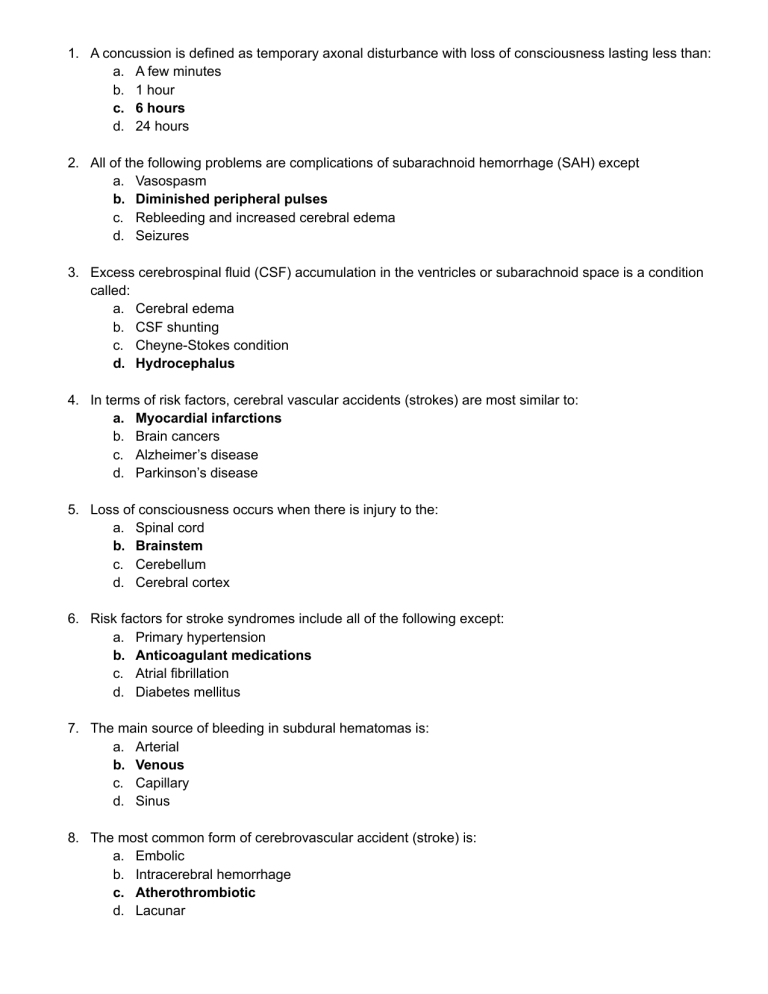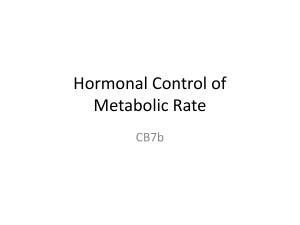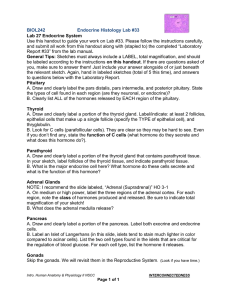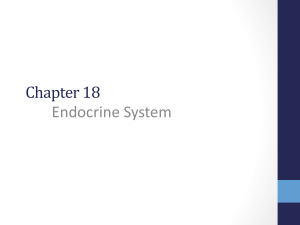
1. A concussion is defined as temporary axonal disturbance with loss of consciousness lasting less than: a. A few minutes b. 1 hour c. 6 hours d. 24 hours 2. All of the following problems are complications of subarachnoid hemorrhage (SAH) except a. Vasospasm b. Diminished peripheral pulses c. Rebleeding and increased cerebral edema d. Seizures 3. Excess cerebrospinal fluid (CSF) accumulation in the ventricles or subarachnoid space is a condition called: a. Cerebral edema b. CSF shunting c. Cheyne-Stokes condition d. Hydrocephalus 4. In terms of risk factors, cerebral vascular accidents (strokes) are most similar to: a. Myocardial infarctions b. Brain cancers c. Alzheimer’s disease d. Parkinson’s disease 5. Loss of consciousness occurs when there is injury to the: a. Spinal cord b. Brainstem c. Cerebellum d. Cerebral cortex 6. Risk factors for stroke syndromes include all of the following except: a. Primary hypertension b. Anticoagulant medications c. Atrial fibrillation d. Diabetes mellitus 7. The main source of bleeding in subdural hematomas is: a. Arterial b. Venous c. Capillary d. Sinus 8. The most common form of cerebrovascular accident (stroke) is: a. Embolic b. Intracerebral hemorrhage c. Atherothrombiotic d. Lacunar 9. Which of the following is not a type of subdural hematoma? a. Chronic b. Intracerebral c. Acute d. Subacute 10. Which of the following manifestations is least likely to affect the MS patient’s ability to ambulate? a. Ataxia b. Hypotonia c. Dysarthria d. Asthenia 11. Which of the following vertebral disorders involves a structural deficit (often hereditary) that causes displacement of affected vertebrae? a. Spinal stenosis b. Spondylosis c. Degenerative disk disease d. Herniated nucleus pulposus 12. Acromegaly is caused by increased secretion of: a. Prolactin b. Growth hormone c. Insulin d. Glucocorticoids 13. Chronic complications of DM include which of the following? a. Peripheral neuropathies b. End-stage renal disease c. Coronary artery disease d. All of the above 14. Cushing disease may be caused by: a. Autoimmune destruction of the adrenal cortex b. Ectopic production of ACTH from a lung tumor c. Excessive production of cortisol from a tumor in the adrenal cortex d. Excessive production of aldosterone from a tumor in the adrenal cortex 15. Graves disease is characterized by: a. Ectopic secretion of thyroid hormone by a tumor b. Excessive production of circulating thyroid-stimulating immunoglobulin c. Autoimmune destruction of the thyroid gland d. Injury to the pituitary, resulting in decreased thyroid-stimulating hormone secretion 16. In adults, the most serious consequence of panhypopituitarism is the loss of: a. Growth hormone b. Luteinizing hormone LH c. Adrenocorticotropic hormone ACTH d. Thyroid stimulating hormone TSH 17. Metabolic abnormalities in Addison disease include all of the following except: a. Hyperkalemia b. Hyponatremia c. Hypoglycemia d. Hypercalcemia 18. Signs and symptoms common to both type 1 and type 2 diabetes mellitus (DM) include all of the following except: a. Polyphagia b. Weight loss c. Polydipsia d. Polyuria 19. Syndrome of inappropriate diuretic hormone (SIADH) results in excessive: a. Renal retention of sodium and water b. Renal retention of sodium without water retention c. Rental retention of water without sodium retention d. Renal excretion of water without sodium retention 20. The most common cause of Addison disease is: a. Adrenal cancer b. Autoimmune injury to the adrenal cortex c. Viral infection of the pituitary gland d. Bacterial infection of the adrenal medulla 21. The pathophysiology of type 1 diabetes mellitus (DM) involves a. Autoimmune destruction of pancreatic beta cells b. Production of antibodies against insulin c. Type IV hypersensitivity against pancreatic islet cells d. All of the above 22. Thyroid carcinoma usually presents with the following thyroid tissue changes: a. Small nodules b. Elevated T3 and T4 c. Large, diffuse goiter d. Thyroid gland atrophy 23. When evaluating the kidney function of an individual wit diabetes insipidus (DI), the nurse would observe: a. High volume urine output b. High urine osmolarity c. Blood in urine d. Protein in urine 24. Which of the following disorders can cause secondary hyperparathyroidism? a. Chronic renal failure b. Primary hyperparathyroidism c. A pituitary tumor d. Graves disease 25. Which of the following thyroid disorders can be caused by exposure of the thyroid gland to ionizing radiation? a. Grave’s disease b. Hashimoto thyroiditis c. Thyroid cancer d. Subacute thyroiditis 26. Estrogen and progesterone are primarily produced and secreted by the: a. Ovaries b. Uterus c. Anterior pituitary d. Posterior pituitary 27. Male sex hrmones are collectively known as: a. Gonadotropes b. Catabolic steroids c. Estrogens d. Androgens 28. The first ovarian phase of the menstrual cycle is the: a. Lunar phase b. Follicular phase c. Adrenache phase d. Luteal phase 29. The release of a matured ovum from the follicle is a process called: a. Reproduction b. Ejaculation c. Menarche d. Ovulation 30. Which of the following structures is not a component of the penis? a. Scrotum b. Glans c. Corpus spongiosum d. Prepuce 31. Which structure is situated just below the urinary bladder in the male? a. Seminal vesicle b. Cowper gland c. Prostate gland d. Montgomery gland 32. An abnormal dilation of veins within the spermatic cord is known as: a. Angiocele b. Spermatocele c. Varicocele d. Hydrocele 33. Penile cancer is associated with which of the following risk factors? a. Human papillomavirus infection b. Smoking c. African or South American country of origin d. All of the above 34. Symptoms of pelvic inflammatory disease include all of the following except: a. Abdominal pain b. Dysparenunia c. Dyschezia d. Dyspnea 35. The protrusion of the uterus into the vaginal canal and possibly outside of the vagina is a condition known as uterine: a. Rectocele b. Relaxation c. Prolapse d. Vulvitis 36. To prevent prostate cancer, me should be encouraged to consume a diet low in: a. Salt b. Fiber c. Fat d. Calcium 37. Which of the following abnormalities is associated with the development of breast cancer? a. Elevated cortisol b. Decreased insulin c. Decreased progesterone d. Elevated estrogen 38. Which of the following statements about ovarian cancer is false? a. In the early stages, ovarian cancer is asymptomatic b. Women 45 years and younger are at the greatest risk c. Ovarian cancer results in ascites caused by seeding of cancer cells within the peritoneal cavity d. Ovarian cancer accounts for the most deaths of all cancers of the female reproductive tract 39. Which of the following symptoms suggests that a woman should be carefully evaluated for breast cancer? a. Dimpling of the skin on the breast b. Enlarged axillary lymph nodes c. Abnormal discharge from the nipple d. All of the above





